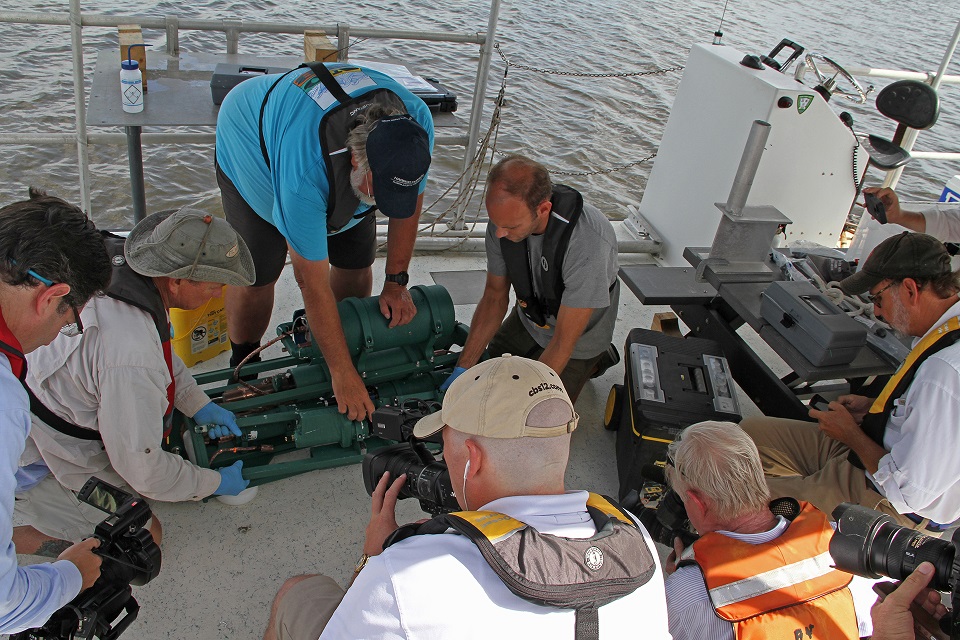FAU Harbor Branch Installs World's Largest LOBO Network
FAU Harbor Branch recently installed the world's largest network of land ocean biogeochemical observatory units in the Indian River Lagoon.

Members of the local media were on site during the installation of one of the LOBO units in the St. Lucie Estuary.
Three years ago, a blanket of microscopic algae covered parts the Indian River Lagoon (IRL), smothering one of the richest marine ecosystems in the continental United States which spans 156 miles along Florida’s east coast. As a result of these algal blooms, 47,000 acres of seagrass in the estuary ecosystem were destroyed, along with 111 manatees, 51 bottlenose dolphins and 300 pelicans in Brevard County.
Meanwhile further south in 2013, toxic microalgae associated with discharges from Lake Okeechobee due to high rainfall released large quantities of freshwater into the estuary, along with nutrients from septic systems, agricultural and lawn fertilizers, and other urban overflow. These same toxins also posed threats to humans who came into physical contact with the algal blooms when they swam, touched or inhaled the toxins produced by the algae.
Recently, scientists from Florida Atlantic University’s Harbor Branch Oceanographic Institute installed one of five new Land Ocean Biogeochemical Observatory (LOBO) units in the St. Lucie Estuary, adding to a water quality monitoring network in the IRL and making it the largest LOBO network anywhere. FAU Harbor Branch’s LOBO project is being funded in part by $2 million from the state legislature via Florida’s Department of Environmental Protection.
“This is a monumental day for Florida and our nation as we embark on a project that will transform our long-standing research to monitor the health of this biodiverse estuary and national treasure,” said Megan Davis, Ph.D., interim executive director and a research professor at FAU Harbor Branch.
The network of remote-controlled sensors offers real-time data from the IRL that is accessible online to anyone, anytime at fau.loboviz.com. On an hourly basis, these sensors will be measuring temperature, salinity, depth (to measure tidal fluctuations), turbidity (particles in the water), water color, dissolved oxygen, pH (a measure of acidity), nitrate, phosphate, and chlorophyll fluorescence, that is a measure of algal chlorophyll in the water.
“In 2011 and 2012, we conducted surveys of the estuary and confirmed that waters off Brevard contained more nitrogen than is acceptable, and levels were much higher there than in the estuary’s southern waters,” said Brian Lapointe, Ph.D., an expert on harmful algal blooms and a research professor at FAU Harbor Branch.
The new LOBOs will help Lapointe’s current work in Martin County which is addressing nutrient pollution.
The IRL has been designated an “Estuary of National Significance,” and is home to one-third of the nation’s manatees who share the estuary with bottlenose dolphins, fish, birds and rare seagrasses. It stretches over 40 percent of Florida’s east coast and carries an economic value of more than $3.5 billion annually. The IRL is composed of three lagoons: Mosquito Lagoon, Banana River and Indian River, which is the main body of water that extends from northern Brevard County to the southern boundary of Martin County, which is where the Indian River Lagoon meets the St. Lucie Estuary. This unique ecosystem supports more than 4,300 species of wildlife as well as tourism and commercial fisheries. It serves as a nursery and spawning ground for many fish and provides approximately 50 percent of annual fish harvest along the east coast of Florida.
“Installing our Land Ocean Biogeochemical Observatory units in the St. Lucie Estuary will expand our LOBO network from Sebastian Inlet to St. Lucie Inlet. This significant water quality monitoring network will provide users the capability to observe and predict real-time,” said Davis. “It will be the eyes on the water to record changes and help resource managers make decisions that will have far reaching impacts on the health of the estuary and the economic engine for this region and the state of Florida.”
FAU Harbor Branch has a long history of conducting research and monitoring the Indian River Lagoon. For decades, scientists at FAU Harbor Branch have studied causes of macroalgae and harmful algal blooms, seagrass productivity and water quality, marine mammal health and population studies, and mercury in the food web. The lead scientist on this project, Dennis Hanisak, Ph.D., said he looks forward to using and sharing this data with anyone who wants to better understand the Indian River Lagoon.
“These data will help us all better understand and appreciate the lagoon, how it works, and how we can do a better job of conserving it for today and for future generations,” he said.-FAU-
Tags: engineering | harbor branch | technology | research | science